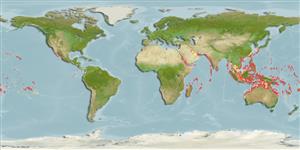>
Eupercaria/misc (Various families in series Eupercaria) >
Labridae (Wrasses) > Corinae
Etymology: Hologymnosus: Greek, holos = full + Greek, gymnos = naked (Ref. 45335).
More on author: Lacepède.
Environment: milieu / climate zone / ລະດັບຄວາມເລິກ / distribution range
ນິເວດວິທະຍາ
ສັດທະເລ ກ່ຽວກັນຫີນ; ລະດັບຄວາມເລິກ 8 - 40 m (Ref. 90102). Tropical; 25°C - 28°C (Ref. 27115); 32°N - 28°S
Indo-Pacific: Red Sea and South Africa (Ref. 11228) to the Society and Pitcairn islands, north to southern Japan, south to southeastern Australia and Rapa Island.
ຂະໜາດ / ນ້ຳໜັກ / Age
ການຈະເລີນເຕັມໄວ: Lm ? range ? - ? cm
Max length : 40.0 cm TL ຕົວຜູ້/ບໍ່ມີເພດ; (Ref. 2334); common length : 34.0 cm TL ຕົວຜູ້/ບໍ່ມີເພດ; (Ref. 5450)
ຄີ (ໜາມ)ແຂງຢູ່ຫຼັງປາ (ທັງໝົດ) : 9; ຄີຫຼັງຂອງປາ (ຄີອ່ອນ) (ທັງໝົດ) : 12; ຄີ(ໜາມ) ແຂງຢູ່ຄີກົ້ນປາ
ກຸ່ມປາກະດູກແຂງ
ຄວາມຖີ່ຂອງກຸ່ມຖ່າຍທອດພັນ
ປາທີ່ມີການເຄື່ອນຍ້າຍຈາກທະເລໄປຫານ້ຳຈືດ ແລະນ້ຳຈືດຫາທະເລ
ປາທີ່ມີການເຄື່ອນຍ້າຍຈາກທະເລແລະໄປໄຂ່ຢູ່ນ້ຳຈືດ
ຄີກົ້ນຂອງປາ
ສັດທີ່ມີກະດູກສັນຫັຼງ
ການຖ່າຍທອດທາງກຳມະພັນຈາກພໍ່ແມ່ຫາລູກ: 3; ຄີກົ້ນຂອງປາ: 12. Two-color forms: the 'true' species in the Indian Ocean and Red Sea and its sibling in the Pacific regions. Females look almost black; males mainly greenish with blue face, of which Indian form shows a white band central to the body, whilst the Pacific form a pale peduncular area when in nuptial mode (Ref. 48636). Juvenile H. annulatus very closely resemble juvenile Malacanthus latovittatus (Ref.1602). Poorly developed pharyngeal teeth (Ref. 1602).
Body shape (shape guide): fusiform / normal; Cross section: compressed.
Found on coral reefs and rocky substrates to depths of at least 30 m (Ref. 9823) on offshore reef slopes (Ref. 90102). Juveniles generally solitary (Ref. 9710). Feeds primarily on small fishes, also on crustaceans (Ref. 2334).
Life cycle and mating behavior
ການຈະເລີນເຕັມໄວ | ການສືບພັນ | ການວາງໄຂ່ | ໄຂ່ | ຄວາມດົກຂອງໄຂ່ປາ | ຕົວອ່ອນ
Pelagic spawner.
Randall, J.E., G.R. Allen and R.C. Steene, 1990. Fishes of the Great Barrier Reef and Coral Sea. University of Hawaii Press, Honolulu, Hawaii. 506 p. (Ref. 2334)
IUCN Red List Status (Ref. 130435: Version 2025-1)
Threat to humans
Harmless
Human uses
ການປະມົງ: ທີ່ເປັນການຄ້າໜ້ອຍ; ຕູ້ປາ: ເປັນສີນຄ້າ
ເຄື່ອງມື
Special reports
Download XML
ແຫຼ່ງອີນເຕີເນັດ
Estimates based on models
Preferred temperature (ເອກະສານອ້າງອີງ
123201): 24.7 - 29.1, mean 28 °C (based on 602 cells).
Phylogenetic diversity index (ເອກະສານອ້າງອີງ
82804): PD
50 = 0.5625 [Uniqueness, from 0.5 = low to 2.0 = high].
Bayesian length-weight: a=0.00977 (0.00466 - 0.02049), b=3.07 (2.90 - 3.24), in cm total length, based on LWR estimates for this (Sub)family-body shape (Ref.
93245).
ຊັ້ນເຂດຮ້ອນ (ເອກະສານອ້າງອີງ
69278): 4.2 ±0.73 se; based on food items.
ຄວາມຢືດຢຸ່ນ (ເອກະສານອ້າງອີງ
120179): ຂະໜາດກາງ, ປະຊາກອນຕຳ່ສຸດທີ່ໃຊ້ເວລາສອງເທົ່າ 1.4 - 4.4 ປີ (Preliminary K or Fecundity.).
Fishing Vulnerability (Ref.
59153): Low to moderate vulnerability (30 of 100).
🛈
Nutrients (Ref.
124155): Calcium = 43 [26, 71] mg/100g; Iron = 0.598 [0.353, 1.077] mg/100g; Protein = 18.7 [15.8, 20.9] %; Omega3 = 0.144 [0.091, 0.223] g/100g; Selenium = 27.8 [16.1, 51.1] μg/100g; VitaminA = 174 [54, 589] μg/100g; Zinc = 1.07 [0.74, 1.62] mg/100g (wet weight);
